

FIRST is a publication produced by East Asia Arup University for our clients and partners, exploring design, innovation and technical solutions for the built environment. It takes its name from the unique model of AU: Foresight, Innovation, Research, Sharing, and Training. If you have any thoughts on business and collaboration opportunities, or questions and comments about the content, we would love to hear back from you at [email protected].
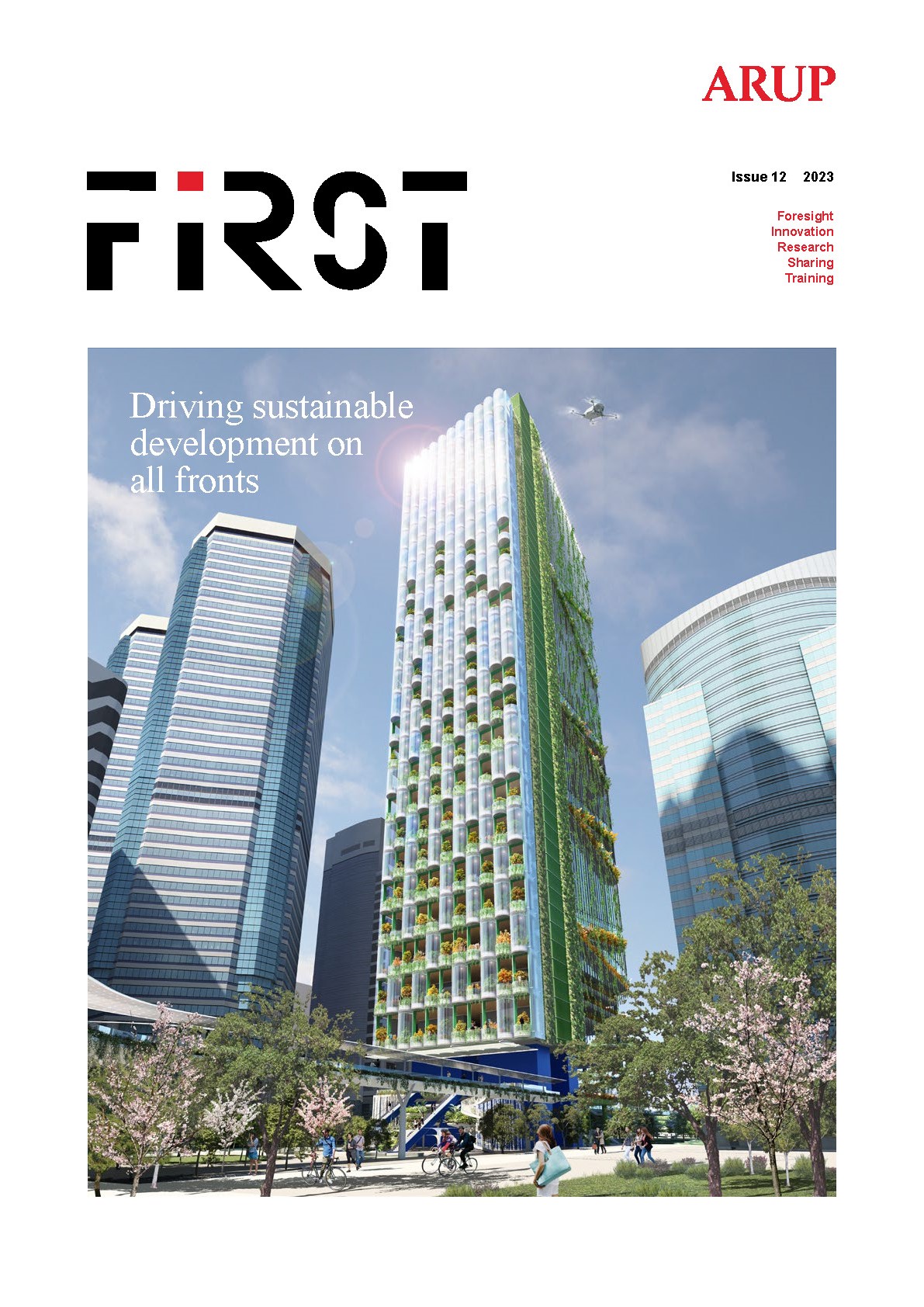
Dedicated to sustainable development, Arup is drawing on our integrated climate and sustainability services to help large organisations and listed companies meet increasingly rigorous ESG compliance standards with actionable recommendations.
Our meticulous planning and engineering design work on offshore wind farm foundations in East Asia showcases our technical competency in delivering excellent solutions to serve the needs of our clients and the planet. You will read from this issue how our engineers from the UK, Hong Kong, Sydney and Tokyo collaborated to develop a unique methodology for Japan's offshore wind farms, considering the country's earthquake-prone nature.
Other highlights include our client research on hydrogen potential for the UK aviation sector, a solar PV feasibility study conducted for the Hong Kong International Airport, as well as some latest energy efficiency and infrastructure resilience planning works for an office building in Shanghai and a smart campus in Guangzhou. These projects demonstrate our diverse expertise in exploring sustainable solutions for different sectors and locations.
This issue also features inspiring personal stories of our esteemed directors Peter Thompson and Bruce Chong, highlighting their career journeys and their commitment to innovation and sustainable development.
Download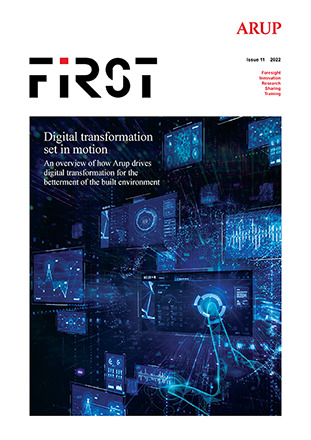
Digital transformation in the architecture, engineering and construction sector has created unparalleled opportunities for improvement in performance, efficiency and cost-effectiveness.
In this issue, we take a close look at how Arup has been driving digitalisation across all disciplines for the betterment of the built environment.
From supporting Hong Kong’s smart cities initiatives to improving building energy efficiency and occupier well-being, and from enhancing infrastructure planning and monitoring to accelerating the shift towards smart mobility across East Asia, we have developed innovative digital solutions that make cities more sustainable and resilient.
All these can be traced back to 2018 when we created a roadmap to support digital transformation initiatives at every level of our organisation. A digital executive board was also formed for the East Asia region to formulate and execute a regional digital transformation strategy.
This top-down strategy is helping move us from vision to action — ensuring everyone across Arup recognises the digital opportunities available and makes them part of their daily activity through various task forces, programmes, training and workshops, research funding support and collaborations with external ventures and universities.
In addition to showcasing how our efforts have come to bear fruit, this issue also features some of our recent research works as well as stories of Peng Liu and Young Wong, who shared their career journey, professional insights and project excellence.
Download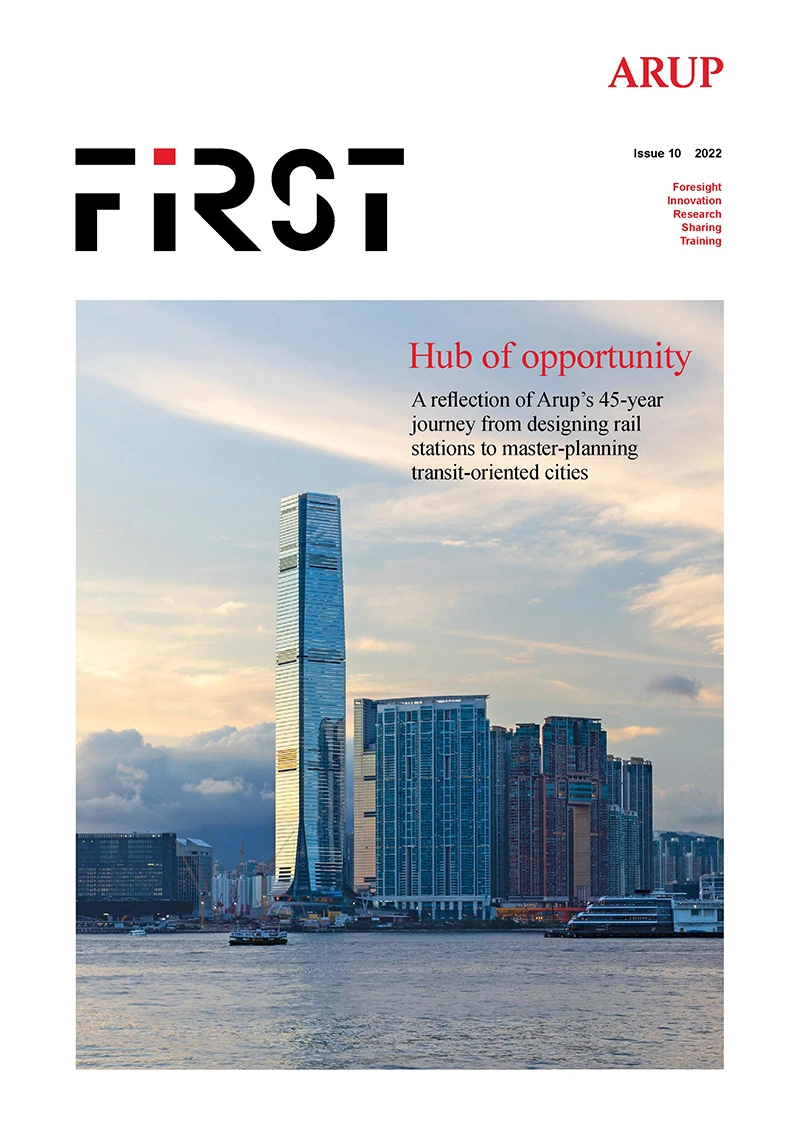
Transit oriented development (TOD) is a concept that recognises the importance of transit for communities and cities. TODs are varied in size and form, but at their core they focus on the idea that dense, walkable urban centres with mixed-use developments near transit hubs can help to reduce urban sprawl, increase inclusivity, improve air quality, and produce more efficient public transportation systems.
The publication of this issue coincides with the 45th anniversary of Arup in Hong Kong. Looking back on our 45 years of technical excellence, we have formulated innovative structural solutions and advanced construction methods to enable the integration of high-rise residential and commercial developments into compact TODs.
Forty-five years on, we take pride in delivering complex TOD projects that make a positive impact on many cities across East Asia and leave a lasting legacy, such as the landmark projects mentioned in the Cover Story as well as the more recent ones featured in greater detail in the Technical Solutions section.
Recognising the benefits of TOD, governments in East Asia are actively promoting TODs and increasingly transit-oriented cities. Felix Ma, Director and China Cities and Advisory Group Leader at Arup, shares his views on China’s latest urban development strategy with TOD and why taller is no longer better in the Profile section.
James Sze, Arup’s Leader of Geotechnics, Maritime & Energy Group in Hong Kong, gives an account of how he has overcome difficult ground conditions since joining Arup in 1995 in his profile.
From designing transit projects in Toronto and Washington to planning transit-oriented cities China’s Greater Bay Area, Arup’s journey of transforming cities around the world continues as it has for the past 45 years.
Download
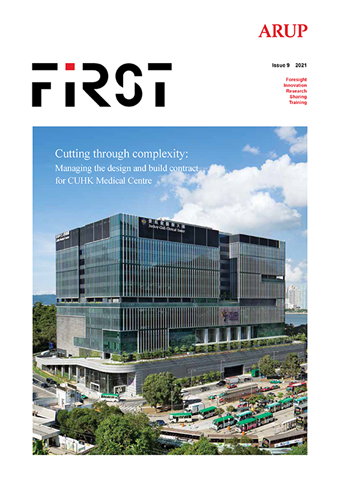
This issue showcases how we are living up to our commitment to sustainable development through our work and research projects.
Planning, designing and building healthcare facilities in the post-COVID 19 era involves complex infrastructure and operational design considerations. The first issue for 2021 takes a close look at some of the latest healthcare projects Arup has worked on across the globe.
Discover how we adopted a systematic approach to managing the complexity of planning, design, construction and operation of the CUHK Medical Centre – the first smart hospital in Hong Kong. We also share how we designed the world’s largest base-isolated hospital in Istanbul within an area that has suffered highly destructive earthquakes in the past.
The global health crisis has prompted not only the healthcare industry but also policymakers, planners and building professionals to rethink the design of future healthcare facilities. Also in this issue, you can read about our recent foresight publication. It envisions that future healthcare infrastructure, delivery models and services will be made resilient enough to mitigate the effects of climate change while providing more inclusive, accessible services to keep citizens healthy at a lower cost.
Also included in this issue are a wide range of research projects and technical solutions we have developed for clients across the region.
Download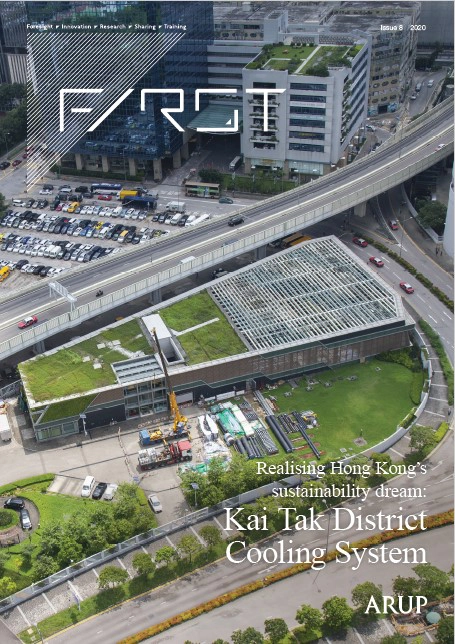
This issue of FIRST showcases some of the works and research projects we have done in living up to our commitment to making meaningful contributions to achieving the 17 United Nations Sustainable Development Goals. The cover article explains why it matters to all of us to shape a sustainable future and the key drivers that will deliver business benefits.
While the list of projects that exemplify our commitment is extensive, this issue brings to you a few specific impactful examples. The Kai Tak District Cooling System reflects our trusted capabilities that cover all phases of this groundbreaking project for Hong Kong, from initial planning to design, to final implementation and ongoing operations.
Extreme weather events put water infrastructure at risk while continuing urbanisation increases demand. In some cases, an ageing water infrastructure needs a major overhaul. Read on to find out our ‘Design with Water’ framework and City Water Resilience Approach to the planning of an integrated water management for Shanghai as the city looks to improve the resilience of its decades-old drainage system.
Every game-changing project begins with feasibility analysis and strategic planning. In this issue we also look at the recommendations we made for Da Nang City, Vietnam on implementing a waste-to-energy facility under the public-private partnership model; and on the Sustainable City plan envisioned by the City of Los Angeles.
Also covered in this issue are the summary of our latest Foresight report, intrapreneurship programme, latest research results, as well as the stories of Vincent Cheng and Sam Chow, who shared their insights on leadership, career development and project success.
Download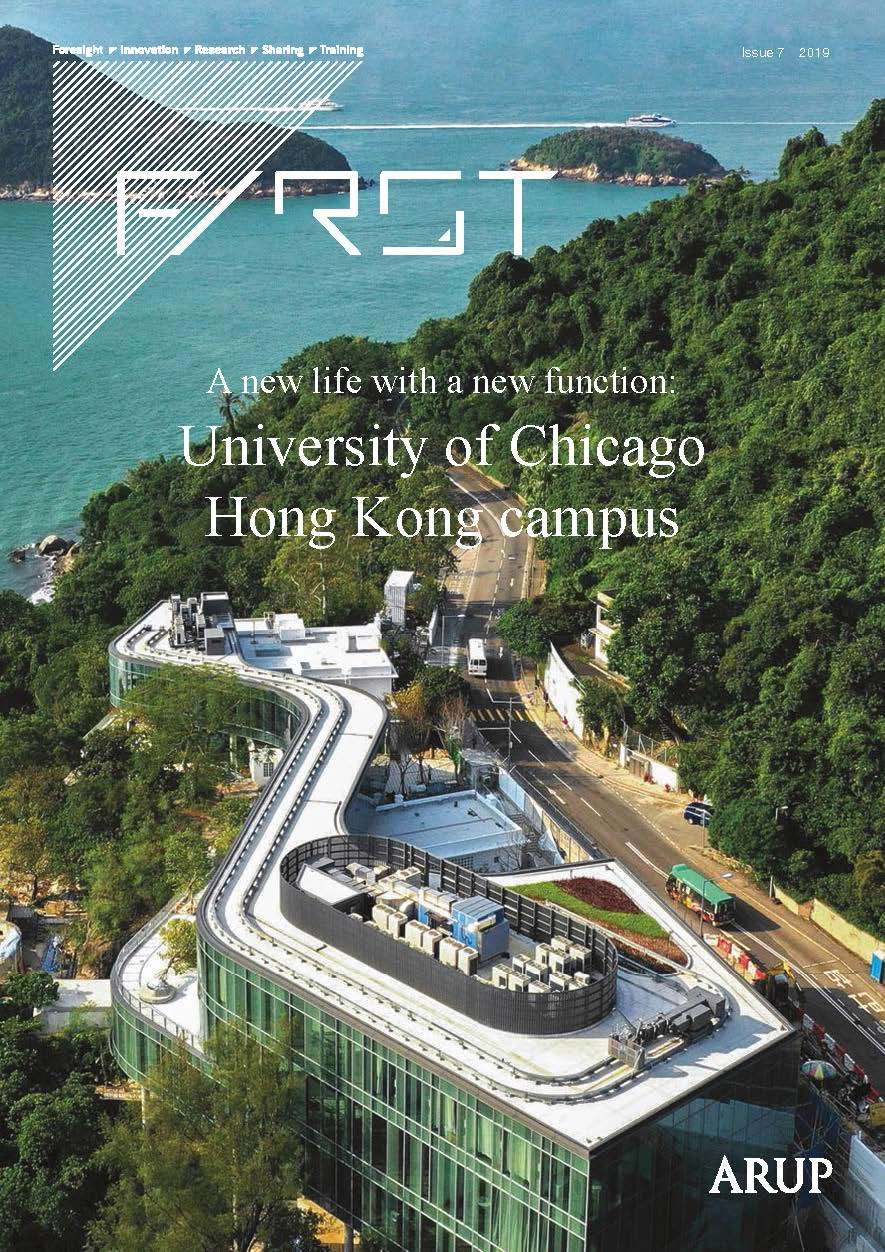
In this issue, you can peek into how we are meaningfully contributing to sustainable development through our projects and in our research. These include how we embedded sustainable design features across the University of Chicago Hong Kong campus, marrying the old with the new to ensure the environmental expectations of students and faculty are addressed. We also look in-depth at the sustainable urban design for Tung Chung New Town Extension and a major upgrade of the existing San Wai Sewage Treatment Works to serve new communities in Hong Kong.
Climate change, bringing with it increasing extreme weather events, is no longer a threat for the future. In this issue, we explore ways to help clients evaluate seismic resilience of their structures and assess the risks of climate change to satisfy the recommendations issued by the Task Force on Climate-related Financial Disclosures.
Also, in this issue, you will hear from Arata Oguri and VC Cheong about their career journeys and what inspired them to persevere and come up with better solutions for their clients. You will also read our foresight, innovation, digital and knowledge management initiatives, which continuously enable us to find a better way to shape a sustainable future.
Download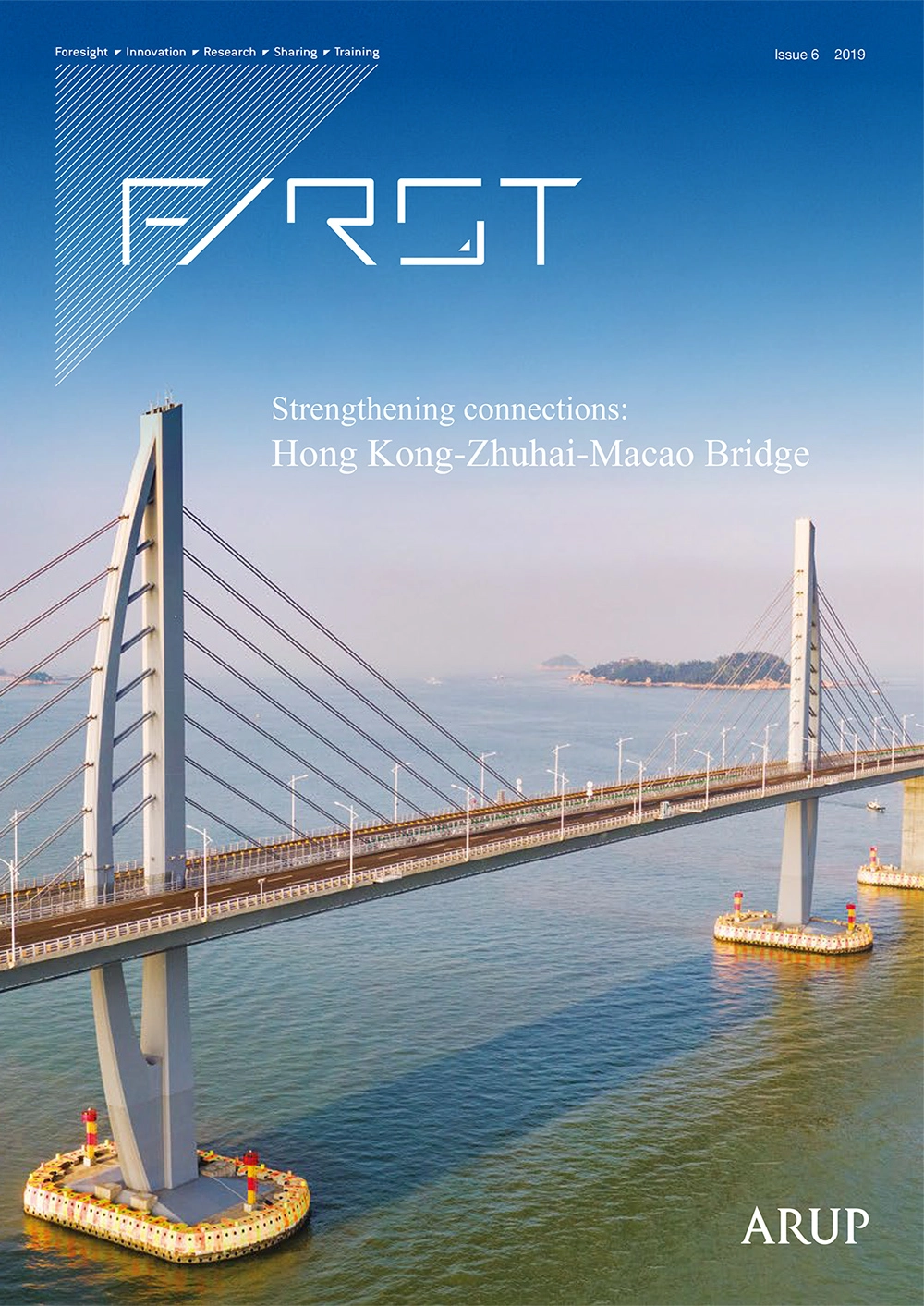
In this edition we look in detail at the Hong Kong-Zhuhai-Macao Bridge – the longest sea crossing in the world – and how we used a BIM-lite approach to realise the iconic design for the Philippines’ second largest airport.
This issue also takes an in-depth look at our innovative solutions to fast-track the design and construction of Vietnam’s tallest building in poor ground conditions and our research work to better understand walking behaviours and improve pedestrian analysis with emerging technology.
We also explore the future of building design, construction and operation, including our total engineering services for Hong Kong’s first building using modular integrated construction technology, the circular economy concept behind the People’s Pavilion made from 100% borrowed materials and our development of a digital hub platform which enables a data-driven approach for smart building operations.
Also in this issue you will learn about our latest foresight updates and hear the stories of Alice Chow and Ander Chow who spearhead the link to Arup’s strategic, technical and management expertise to drive lasting value for our clients.
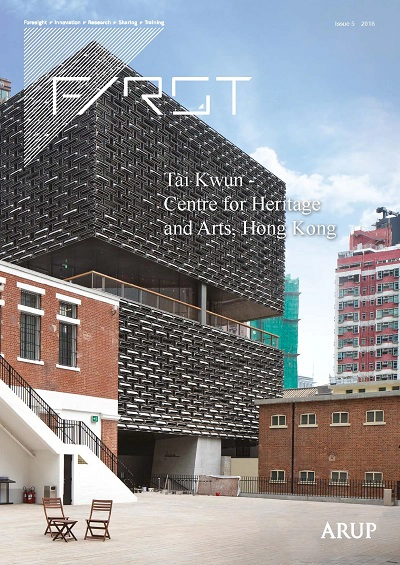
In this issue you will read about some of our latest digital innovations that have helped streamline the design process and deliver better outcomes for our clients.
These include the sophisticated parametric design that has optimised the structural system of Beijing’s tallest building; a web-based platform to increase data analytics capability for building performance simulation; a new modelling approach to quantify the urban heat island effect that enables early involvement of planners and architects; and innovative applications of mobile laser scanning to collect high quality data for design.
The advancement of technology enables us to achieve what previously seemed impossible. From the Tai Kwun - Centre for Heritage and Arts in Hong Kong to the V&A Grain Silo Complex in Cape Town, our solutions are bringing a new life into historical buildings and engineering a future for the past. In Japan, we have helped to rebuild the city hall for resilience and sustainability, providing a catalyst for the downtown area.
Also in this issue you will read our latest foresight reports and stories of KO Yeung and Berny Ng, who have led many technical breakthroughs for ambitious systems and structures in Hong Kong.
Download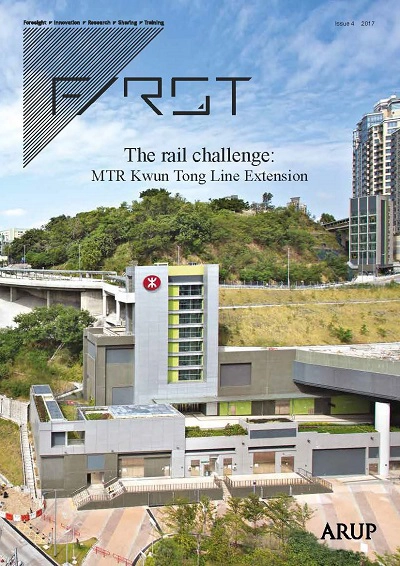
In this issue, you will read about how our out-of-the-box approach is helping cities explore new dimensions for an improved urban experience:
All these cutting-edge solutions are firmly underpinned by our continuous research to understand the future and to find a better way for design, especially the exploration of what digital technology can offer. There is a range of foresight reports and research projects in this issue, from emerging technologies affecting the engineering and construction industry to an assessment tool that helps cities better understand their climate challenges and improve the way they coordinate their policies.
Arup is all about people – they are at the heart of the firm and its pursuit of quality and creativity. Among the people featured in this issue are Wilfred Lau, who initiated the Smart Green Resilient concept to develop Asian cities, and Goman Ho, the man behind many of Asia’s most impressive skylines.
Download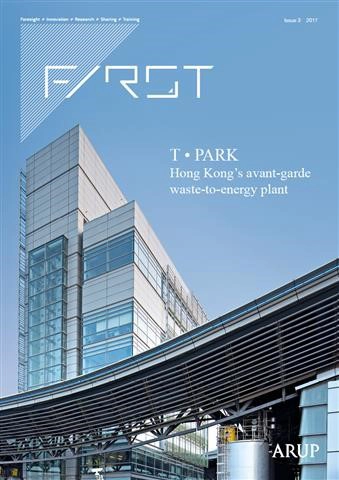
Around the world, cities are struggling to come to terms with the impact of ever-scarcer resources, growing populations and climate change. In this issue of FIRST, we take a close look at how we are exploring smart, sustainable solutions that align with our clients’ commercial, environmental and social priorities in a period of unparalleled urbanisation.
One of our recent showcase projects is the T • PARK sludge facility in Hong Kong which provides an eco-friendly solution to the problem of sewage treatment facing the city. In Shanghai, we deployed a wide range of energy-saving strategies for The Hub which transforms Hongqiao into a vibrant, low-carbon business district. Not only do we do eco-friendly new build, but we also innovate ‘out of the box for a box’ – offering a cost-effective alternative to retrofitting for the Kuzumi Electronics Laboratory.
At Arup, we believe that digital technology and data have a major role to play in finding new ways to meet today’s challenges. Inside this issue, you will read about how we are using advanced digital tools to design the unique structure of (W)rapper Tower in Los Angeles and find out more about our in-house developed scripting and visualisation tool that integrates environmental analysis results into BIM applications for better building sustainability.
Also in this issue you will read the stories of Eric Chan and Timothy Suen, two technical leaders who are devoted to connecting people and places with better roads and railways. Meanwhile, Bruce Chong shares his experience as the first doctoral graduate supported by East Asia Arup University.
This issue also presents some of our recent foresight reports and research studies on topical issues ranging from the circular economy in the built environment to addressing the vulnerability of ageing populations.
Download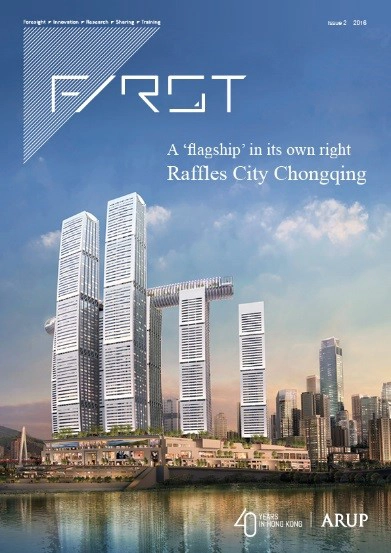
Emerging technologies are constantly pushing the limits of possibilities by mixing the old with the new or remixing the old in the ways we’d never imagined before. In this issue, we take a close look at some innovative solutions we recently developed through mixing and remixing – the hybrid outrigger system which is critical to realise the rising symbol in Western China and the hybrid approach to combine the advantages of additive manufacturing with the technical familiarity of investment casting.
Also in this issue, we shine a light on transport infrastructure, from the Midfield Concourse at Hong Kong International Airport to Arnhem Station in the Netherlands. We not only develop fresh solutions for demanding technical challenges but also research into how such transport hubs can better drive city development together with the space above, below and around.
Innovation often starts with foresight. Here we discuss two of the latest foresight publications – Cities Alive: 100 issues shaping future cities, and Future Lujiazui which presents our ideas for future smart communities.
In this issue, we are pleased to feature Colin Wade, a living dictionary of Hong Kong’s railway development; and Kang Man, one of the earliest Hong Kong engineers who ventured into mainland China. We’d also like to share with you some of the amazing projects we’ve had the privilege to work on recently including NTT FDC2, a state-of-the-art home for data, and Foshan Lingnan Tiandi, the world’s first LEED-ND Gold certified retail community.
Download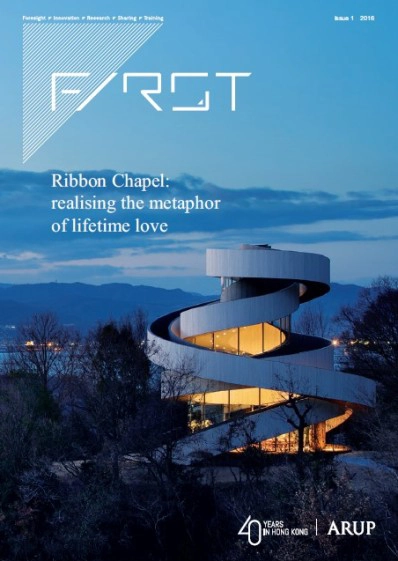
Welcome to the inaugural issue of FIRST, an Arup magazine which takes a close look at the cutting edge of the built environment.
Arup strives to deliver new thinking and design and technical excellence in support of our clients’ projects and aspirations. At the heart of this commitment is Arup University (AU) which, unlike conventional corporate universities, offers a wide range of services and resources to help both our staff and the wider industry to explore fresh ideas, sharpen new skills and share knowledge across disciplines.
AU follows a unique model which, as inspiration for the name of this magazine, involves
Foresight, Innovation, Research, Sharing and Training.
We have a 3-phase approach — Now, New, and Next:
Now: Sharing and training focus on current business needs. Our experienced engineers are trained and accredited to deliver technical courses which are shared globally within Arup and will soon be available to our business partners. Seminars and workshops are held regularly, both internally and externally, to share the latest technologies with our staff, our clients and the wider community.
New: Research grows new ideas and develops innovative technologies/products. Arup delivers outcome-focused research as well as practical services in strategic research planning. We do this in response to our clients’ challenges, in partnerships with academia and industry worldwide.
Next: Foresight explores future trends. We help our clients understand the emerging trends affecting the built environment, explore new ideas and think more comprehensively about the future and how to manage opportunities, risks and uncertainty.
Download